Japanese Design Archive Survey
DESIGN ARCHIVE
Designers & Creators
Makoto Wada
Illustrator, graphic designer
Date: 3 July 2023, 13:30-15:30
Method of interview: 888books
Interviewees: Hiroko Yoshida(888books)
Interviewers: Yasuko Seki, Aia Urakawa
Writing: Aia Urakawa
PROFILE
Profile
Makoto Wada
Illustrator, graphic designer
1936 Born in Higashisumiyoshi Ward, Osaka
1957 "Marguerite by Night", winner of the Japan Advertising Artists Club Award at the 7th Japan Advertising Artists Club Exhibition
1959 Graduated from Tama Art University, Department of Design (now Department of Graphic Design), and joined LIGHT PUBLICITY (-1968)
1961 Animated the first episode of NHK's "Minna no Uta", "Daremo shiranai"
1964 Short animation "MURDER! " produced, Mainichi Publishing Culture Award, Mainichi Film Ofuji Noburo Award the following year. Founded Tokyo Illustrators Club with Tadanori Yokoo and Akira Uno
1968 Establishes Makoto Wada Office
1977 Started cover art for "SHUKAN BUNSHUN" (- ongoing as an encore project)
1984 Directed first film "Majjan hourouki", won the 9th Hochi Film Newcomer Award for Best Newcomer
1997 Picture book "Neko no Shijimi" awarded Japan Picture Book Award, Solo exhibition "Jikan ryokou" held at Creation Gallery G8/Guardian Garden, awarded Mainichi Design Awards
2011 Produced 1060 charity illustrations for the Great East Japan Earthquake (-2014)
2019 Passed away
Mainichi Publishing Culture Award, Art Directors Club Annual Awards, Bungeishunju Manga Award, KODANSHA Publication Culture Award for Book Design, KODANSHA Publication Culture Award for illustration, Fumiko Yamaji Cultural Foundation Special Award, Blue Ribbon Awards, KODANSHA Essay Prize, Kikuchi Kan Prize, Sankei Children's Book Award, Mainichi Film Japan Book Design Awards, Mainichi Design Awards, Japan Advertising Award, Yamana Award, Nagaharu Yodogawa Award, Japan Book Design Awards Exhibition, Japan Book Publishers Association President's Award, Japan Cartoonists Association Award and many other awards.
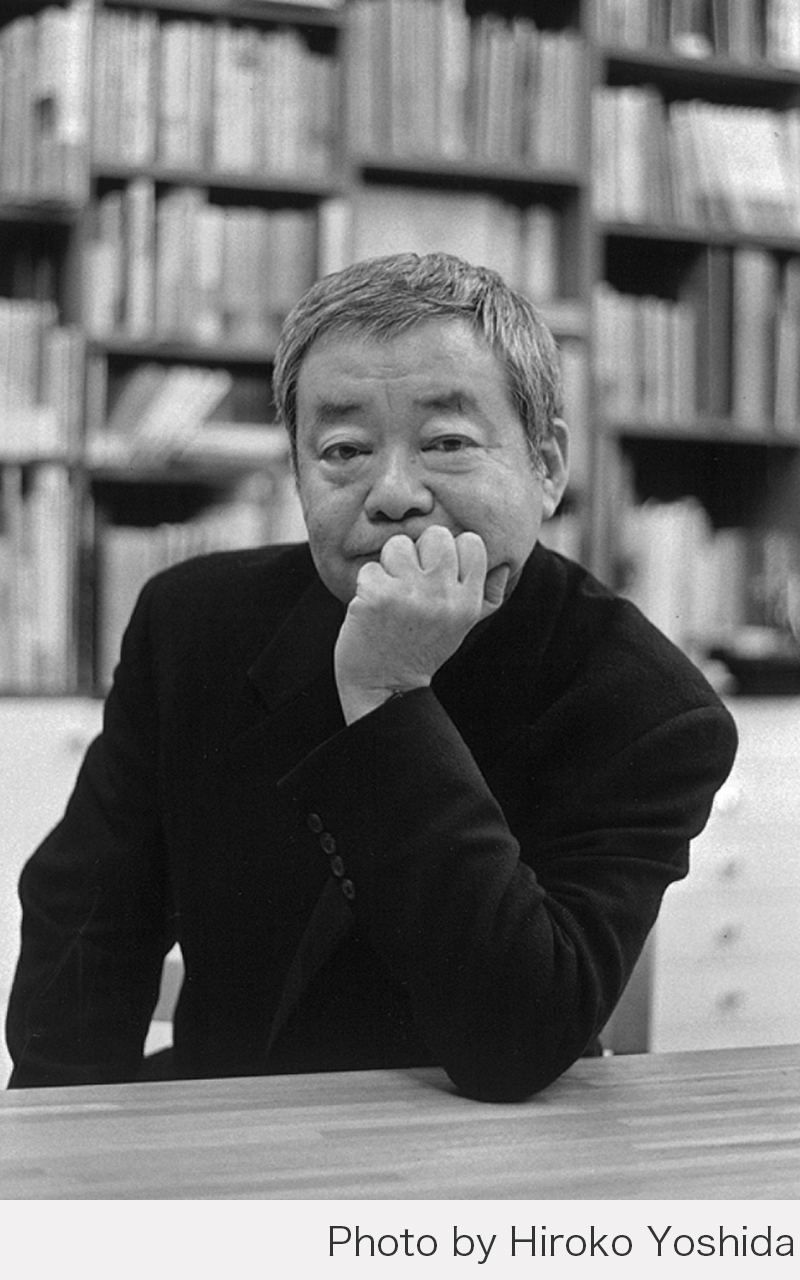
Description
Description
One word to describe Makoto Wada would be "multi-talented". In his 83 years of life, he has worked in a wide range of fields, including illustration, graphic design, art direction, book design, film (director and screenplay), picture books, animation, songwriting and composition, haiku and rakugo, and has a reputation for being first class in all of them. As he says, his work was connected to his life "in a chain reaction", and I believe he lived a happy life, following his spirit of inquiry and curiosity and pursuing what he liked. Moreover, he has received a number of prestigious awards, including the ADC Award for his art direction of the magazine "Hanashi no tokusyu", the Blue Ribbon Awards for the film "Kaitou Rubi" (director and screenplay), the Japan Picture Book Award for his picture book "Neko no Shijimi" (written and illustrated) and the Kikuchi Kan Prize for his wide-ranging activities, and his achievements in diverse fields are astonishing. Wada's main creative focus was illustration, and it is worth noting in the history of design that he was instrumental in establishing the status of illustrators and expanding their field of activity.
Wada was already drawing stories composed of pictures and text at the age of four. While a student at Tama Art University, his poster "Marguerite De La Nuit" won an award at the Japan Advertising Artists Club exhibition and led to work for magazines and TV commercials. After graduation, he joined LIGHT PUBLICITY, Japan's first company specialising in advertising production. Tadanori Yokoo and Akira Uno, who were contemporaries at the Nippon Design Center in the same Ginza district, often discussed their dreams as illustrators with each other. In the 1960s, illustration work was recognised in the advertising industry, but few illustrators were employed in the publishing industry, and book and magazine designs and illustrations were done by artists and book designers.
So Wada, Yokoo and Uno called on their predecessors and comrades to form the Tokyo Illustrators Society in 1964. Members included Tadashi Ohashi, Yoshio Hayakawa, Tadahito Nadamoto, Yoshitaro Isaka, Kiyoshi Awazu, Ryohei Yanagihara, Akira Mohri, Harumi Yamaguchi and Tsunao Harada, among others. In his book "Ginza kaiwai dokidoki no hibi" (BUNGEISHUNJU, 1993), Wada states that "although the yearbooks and exhibitions were visible activities, the more significant thing was that many people became aware of the existence of illustrators through them. In fact, Wada was involved in the cover design of magazines such as "SHUKAN BUNSHUN" for many years and has designed more than 2,000 book covers for books.
Almost all of Wada's archive materials were stored and managed in the Makoto Wada Office. They include original drawings, prints, paintings, posters, design works, documents and books, and in March 2020 a donation agreement was signed with the Tama Art University Art Archives Center (AAC), donating a total of over 50,000 items. With approximately 2,800 works, including this AAC material, a travelling exhibition, "Makoto Wada Exhibition", is being organised, starting with the Tokyo Opera City Art Gallery in 2021. We spoke to Ms. Hiroko Yoshida of 888books, who knew Makoto Wada well before his death, who supervised the planning of this exhibition and edited the catalogue.
Masterpiece
Masterpiece
Posters
"Marguerite De La Nuit" (1957); Shinjuku Nikkatsu Meiga-za (1959-1968); Sogetsu Art Center (1960-); Theatre Apple (1982-1998); The International Exposition, Tsukuba, Japan, 1985 (1985); Katsushika Symphony Hall (1992-2002)
Logo and Marks
LIGHT PUBLICITY (1960); Mainichi Design Awards (1963); Tokyo Illustrators Club (1966); DUG (1968); HOKUREN Federation of Agricultural Cooperatives (1973); Tokyo International Film Festival (1984); Shochiku Kageki Dan (1991); Japan Animation Association (1997); Nippon Shinyaku 2007); Tokyo Illustrators Society (2013)
Magazine
"Hanashi no tokusyu" art direction (Nihon-sha, etc., 1965-1995); "Shukan Bunshun" cover + design (Bungeishunju, 1977-); "Swing Journal" cover (Swing Journal, 1966-); "Weekly Sankei" cover (Sankei Shimbun, 1968-1973) magazine
Book design (illustrations)
"Jazu o tanoshimu hon" (edited by Shuji Terayama and Reiko Yukawa, Kubo Shoten, 1961); "Kimagure roboto" (text by Shinichi Hoshi, rironsha, 1966); "Gutara ningengaku" (text by Shusaku Endo, Kodansha, 1972); "Madogiwa no toto chan" (text by Tetsuko Kuroyanagi, cover illustrated by Chihiro Iwasaki, KODANSHA, 1981); "Maza gusu 1-4" (translated by Shuntaro Tanikawa, KODANSHA, 1981-1985); "Murakami haruki zensakuhin 1990-2000" (text by Haruki Murakami, KODANSHA, 2004); "Kappo suru Souseki" (text by Saiichi Maruya, KODANSHA,2000)
Chidren's books
"Nusumareta tsuki" (Iwasaki Shoten, 1963); "Mitsurinichi kireina hyo no hanashi" (text by Naoko Kudo, Gingasha, 1975); "Ana" (text by Shuntaro Tanikawa, Fukuinkan Shoten, 1976); "Neko no Shijimi" (Holp Shuppan Publications, 1996); "Donna kanjikana" (text by Chinatsu Nakayama, JIYUKOKUMINSHA, 2005)
Newspapers
"Konsyu no hondana"(The Mainichi Newspapers, 1992-2018); "Mitani Koki no arifureta seikatsu"(The Asahi Shimbun Company, 2000-)
Advertisements
Peace (1961-1964); Canon (1965); KAGOME (1973);Nippon Shinyaku (1971-1996); NTT (1986-1994); Fujitsu (1991-1992)
Animations
"Dare mo shiranai" (NHK Minna no uta, 1961); "MURDER! " (Sogetsu Art Center, 1964); "Goluden yougagekijyou" (Fuji Television Network, 1981); "Kaitou Zigoma ongaku hen" (TOHO, 1987)
Films
"Majjan hourouki" (TOEI COMPANY, 1984); "Kaitou Rubi" (TOHO, 1988); "Kowagaru hitobito" (SHOCHIKU, 1994); "Mayonaka made" (TOHOKUSHINSHA FILM CORPORATION, 2001)
Books
"Wada Makoto shouzou gasyu PEOPLE" (BIJUTSU SHUPPAN-SHA, 1973); "Otanoshimi wa korekarada" 1-7 (BUNGEISHUNJU, 1975〜1997 / KokushoKankokai, collector's edition 2022); "Ginzakaiwai dokidoki no hibi"(BUNGEISHUNJU, 1997); "Shiroi uso"(Goyou Shuppan, 2002); "Wada Makoto Jikan ryokou"(MEDIA FACTORY, 2000 / GENKOSHA, revised edition 2018); more than 200 other books.
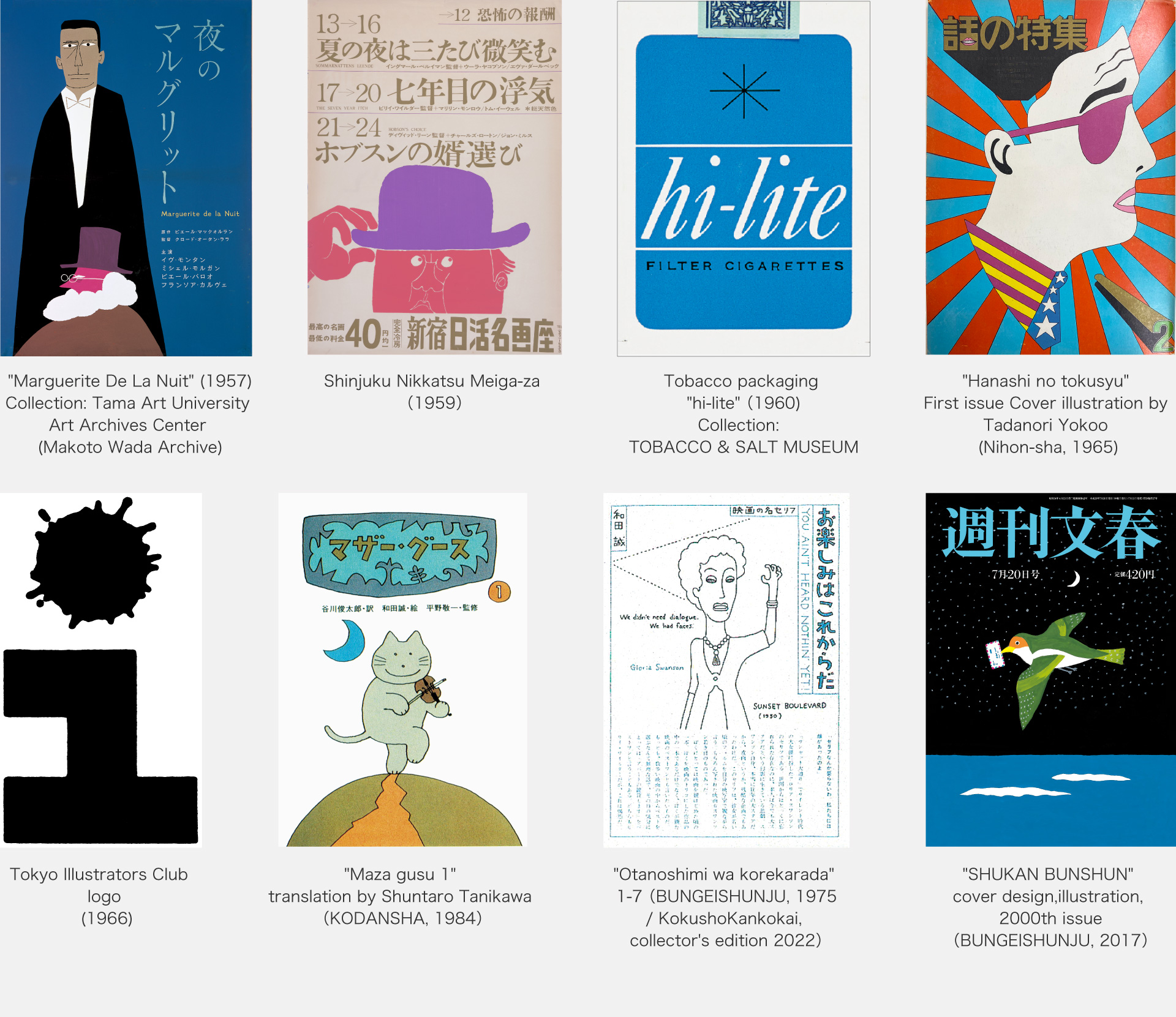
Interview
Interview
"I hope there will be a memorial museum,' and 'When I'm gone, that's it."
He may have changed his mind from time to time.
Encounters with Makoto Wada and his character
ー Thank you very much for showing us the "Wada Makoto" touring exhibition at Museum「EKi」KYOTO the other day. He has done a wide range of work, so the variety of works on display was well worth seeing. You were involved in the planning of this exhibition, and you used to be the editor of GENKOSHA's "illustration" magazine.
Yoshida Yes, that's right. The first time I worked with Mr. Wada was right after I joined the editorial department. Newcomers were in charge of the magazine competition "the Choice", which was a gateway to success for illustrators, and Mr. Wada was a member of the jury. That was in 1994, so we have known each other for a long time. I was impressed that he was very busy and very enthusiastic in his judging. Mr. Wada said that he did not accept judging where a number of judges make a majority decision, but he accepted "the Choice" because it was a "one-person judging".
After that, Mr. Wada proposed a series of interviews with illustrators at their workplaces ("Shigotoba taidan"), and I accompanied him once every two months, and over the four years of the series, I have interviewed Ms. Yoko Yamamoto, Ms. Kodue Hibino, Mr. Shinbo Minami, Mr. Teruhiko Yumura and 24 others. During this time, we also covered Mr. Wada's work, went to events and worked with him at the opening parties of various illustrators' exhibitions.
ー In your view, what was Mr. Wada like?
Yoshida When I first met him, he was just before 60 years old. He's not the kind of guy who is affectionate, so I was a bit scared at first, partly because I was nervous. But when I actually worked with him, he was kind and answered all my questions and was very helpful. I was a fledgling editor, and I can say that he helped me to grow up. His attitude towards people does not change depending on their title, so as long as you work hard on the spot, he treats you regardless of whether you are a newcomer or a veteran. In his later years, he became more and more conciliatory, and those who met him for the first time in his later years said he was "smiling, soft and gentle". The same was true for the young illustrators, who were like a cloud to them, but they were very friendly and often saw the work of young people in galleries in the Omotesando area.
He was knowledgeable and versatile, knowing everything except sports, and his mind was very quick. And he was a very caring person. At the party for illustrator Mr. Tadahito Nadamoto when he was awarded the Medal with Purple Ribbon, he spared no effort to entertain people for the sake of the person, including organising and hosting the party. When he published a collection of haiku entitled "Shiroi uso", a party was held at the Chinese-style restaurant "fumin" in Aoyama, Tokyo, to celebrate its publication. 50 people attended, and he wrote a haiku for each of them on the door of the book, I was surprised that he wrote a phrase for each participant on the door of the book, which was later mailed to those who couldn't make it on the day.
After the Great East Japan Earthquake, he drew and sold 10 postcard-sized pictures every week and donated the proceeds from the sale of all 1,060.
ー There are many designers who dress in branded clothes, but how about Mr. Wada?
Yoshida He would say my clothes are indifferent - jeans, T-shirt and New Balance sneakers. He used to wear a cap and carry only a BUNGEISHUNJU handbag in which he put his galley proofs and other materials. He also loved the stadium jumper that was given to him on his 60th birthday. He wore jeans everywhere he went, but when he visited the workplace of the respected Mr. Tadashi Ohashi for the series of "Shigotoba taidan" articles, he wore a tie and a jacket.
ー I think you met many other illustrators, but were you particularly close to Mr. Wada among them?
Yoshida Yes, even after I retired from GENKOSHA, I continued to work with Mr. Wada on books and we continued our relationship. After I retired, I set up a small publishing company with editors, and we asked Mr. Wada to design the company logo. As a design fee for him, we just treated him to a beer in the beer garden. Later, in 2015, I set up an art publishing company on my own and had a gallery space, so this time I asked Mr. Wada to design the logo for the gallery for free. Not only logos, but he also did quite a lot of work for free.
Attitude and approach to work
ー You visited Mr. Wada's office many times, how many staff members were there?
Yoshida Sometimes there were three staff members, but more often there were two. Some had been assistants since the LIGHT PUBLICITY days, others for more than 20 years. Mr. Wada himself did everything by hand, but in his last years his assistants did the work for digital submissions.
ー What was the structure and how did they work in the office? For example, did the boss, Mr. Wada, take the lead and his assistant would draw a clean draft?
Yoshida Basically, all the designs and illustrations are produced by Mr. Wada. He also specified the CMYK (colours to be used in printing) colours on the print (manuscript for plate-making). I don't know all the details, but I think that his assistants were responsible for drawing the prints (marks for cutting positions), resizing the prints, and making the paper prints (line drawings and hand-drawn text printed on photographic paper). He was also the only one who had meetings.
I remember being surprised to see the huge number of long, thin strips of paper with work details and deadlines written on them, which were pasted on the assistants' computers, and when the work was finished, the strips were removed and the bottom ones moved up, just like an order at a ramen shop. The magazine "DESIGNERS' WORKSHOP" serialised his work for two years from 1991, and in two days he drew the cover of "SHUKAN BUNSHUN", did three colour proofs, a book design and more than a dozen illustrations. The workload is so large and so fast that I wondered if there was actually more than one Mr. Wada? I even joked about it with my fellow editors.
He used to walk 40 minutes from his home to the office, arriving at around 11am and finishing in the evening, after which he would go to the opening party of an exhibition, meet friends and acquaintances, have a dialogue interview starting in the evening, or go to a concert. He comes to work on weekends and public holidays, and said he can concentrate on drawing because the phone doesn't ring and he is alone. At home, he would sometimes read the galley proofs, but he never seemed to draw illustrations.
ー You know the inner workings of the office very well. Did you visit frequently?
Yoshida There were times when I went there every day, depending on the work situation. I can bring you meetings and colour proofs. Mr. Wada didn't like to communicate only by phone, courier or motorbike, but would have face-to-face meetings and hand-deliver illustrations and hand-deliver the galley proofs. He worked so quickly that Mr. Wada would often call me directly before the deadline to say that the work was ready and to come and pick it up.
The meeting itself lasted only a few minutes. Afterwards, we would chat about other things. In my case, he would say something like "I liked the work of the illustrator" or "Did you see that exhibition?". Or I was shown art books by Ben Shahn and Saul Steinberg, who were Mr. Wada's favourites. I think they had different conversations from those who worked in film or music, but with those who could talk about maniacal things, they sometimes had a three-minute meeting and two hours of chatting.
ー Mr. Wada When he was making illustrations, did he make preliminary sketches or sketches of ideas?
Yoshida He did make preliminary sketches.
The production was filmed for the exhibition "The Work of Makoto Wada" at the TOBACCO & SALT MUSEUM in 2010. At that time he made a rough sketch in pencil on the production paper, which was then drawn on top with Rotring and paint. So there are rarely any preliminary sketches left besides the main drawing, except for the colour ink works. He drew through the underdrawing, as the colours would be muddy if applied directly over the pencil underdrawing with coloured ink. This is why the underdrawing remains.
He didn't have a way of working, where he would send out a few rough drafts in advance, so there wasn't a lot of advertising work. He was very thorough in designing his own illustrations. The exception to this was when it was someone histrusted, like his friends from the LIGHT PUBLICITY days, the art director and designer Mr. Gan (Iwao) Hosoya, He would take on advertising work.
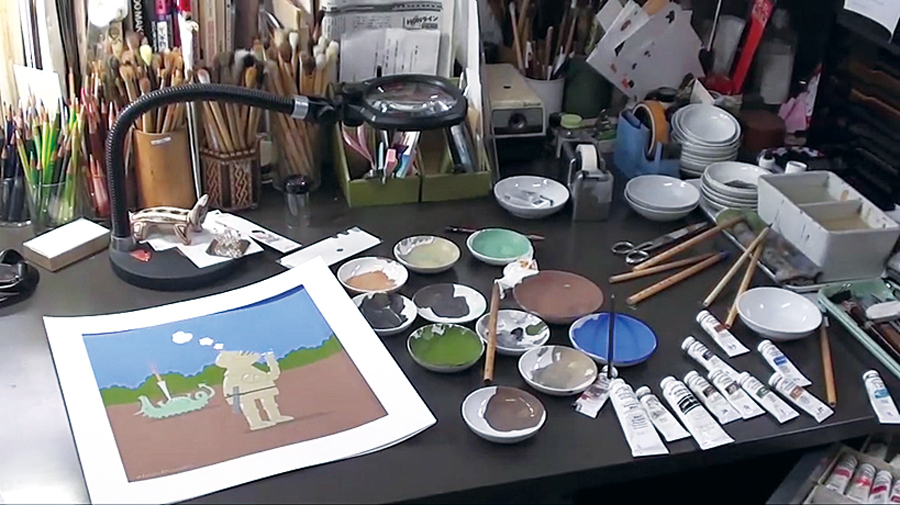
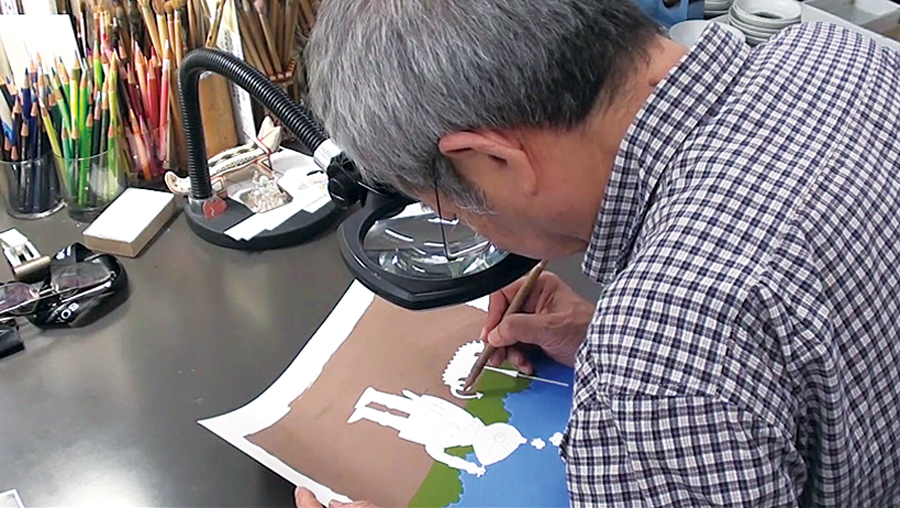
Makoto Wada's work desk in his office (left), showing a drawing scene using gouache. From the video "Working on" (2010), Photos courtesy of TOBACCO & SALT MUSEUM, Photos by Hiroko Yoshida
ー Mr. Wada does not do much commercial work. In the beginning, he did tobacco packaging for "hi-lite" and newspaper ads for Canon cameras.
Yoshida When He was at LIGHT PUBLICITY, his work was mainly in advertising. However, when he first joined the company, he would show it to the client at the colour proof stage and only the text errors would be checked, but times have changed and the environment for ad production has changed, with clients asking for a check at the mid-stage and a few rough drafts. He states that such an approach is not suitable for him.
ー At that time, there were probably a lot of people who quit their jobs and went freelance who didn't want to work at the behest of others. On the other hand, I think Mr. Wada had a talent for attracting the kind of work he wanted to do. He was able to work in many of his favourite fields: film and jazz posters, record jackets and book design.
Yoshida One job leads to another, which in turn attracts work in other fields. According to Mr. Wada, it spread like a "in a chain reaction". As he drew pictures for picture books, he also wanted to write, and as an extension of creating children's stories, he composed nursery rhymes, worked with musicians, created concert posters, and went on to compose and direct stage plays and even direct films.
A prime example is when Mr. Wada was having a drink with film producer Mr. Haruki Kadokawa at a bar and when Mr. Kadokawa asked what he wanted to do next, he said, "I want to write a film scenario", which led to him becoming a film director. In total, he had directed and written four films and one short film, winning the Hochi Film Awards Newcomer Award for "Mahjong Horoki" and the Blue Ribbon Awards for "Kaitou Rubi".
ー What is it about Mr. Wada's work that appeals to you from an editor's point of view?
Yoshida Mr. Wada is sincere in his approach to the content we present to him. That said, they do not limit themselves to the scope of the client's imagination, but give us something that incorporates ideas, which is an amazing thing. It's not flashy, but it's a work that permeates the audience. Whether it's a book design or a theatre poster, the artist thought about it in line with the content, and used different materials such as acrylic paint, gouache, coloured inks, colour specifications and prints, with a variety of styles. And I think it has a modernity and universality that doesn't become old-fashioned over time." The first cover of SHUKAN BUNSHUN was illustrated more than 40 years ago, but looking at it now, it doesn't look old at all.
How the "Makoto Wada Exhibition" project came about
ー Can you tell us how the "Makoto Wada Exhibition" project came about?
Yoshida After Mr. Wada passed away in October 2019, the bereaved family and office staff decided to hold a farewell party of sorts in March 2020, called "A party around Mr. Wada", and I was helping out. It canceled due to the pandemic of the new coronavirus, but in the meantime, I proposed "Makoto Wada Exhibition" to the bereaved family and the office in frequent correspondence with them. Fortunately, the bereaved family and the office readily agreed, and we were able to move forward with the implementation of the exhibition.Together with BlueSheep, which is planning and producing the exhibition, we have begun preparations for the "Makoto Wada Exhibition".
Mr. Wada had organised many his exhibitions in the past, but most of them had been dedicated to a limited range of genres, such as graphic design, picture books and films, and very few had been compiled in his entire work. After his death, I learned that even those who were close to Mr. Wada knew only one aspect of his work. For example, people in the film industry did not know much about his work on picture books. So we decided to focus on showing Mr. Wada's diverse aspects collectively. The subtitle of the exhibition is "This, that and the other", because we wanted to convey the fact that we come into contact with Mr. Wada's work in various aspects of our lives without even knowing it.
The first venue was the Tokyo Opera City Art Gallery. It was mainly a contemporary art exhibition, but there was also an exhibition on Shuntaro Tanikawa, and the place had many unexpected points of contact, such as Mr. Toru Takemitsu and Mr. Wada being close friends.

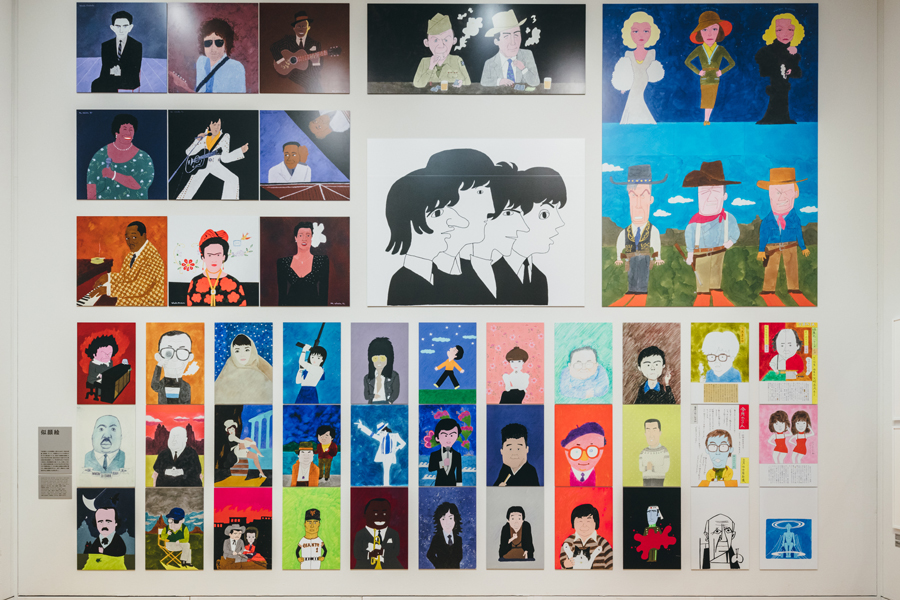
"Makoto Wada Exhibition" at Tokyo Opera City Art Gallery, 2021. Photos by Nao Shimizu
ー How long did it take to prepare for the exhibition?
Yoshida We received official approval from the bereaved family and the office in early 2020, submitted a proposal to Tokyo Opera City Art Gallery and the exhibition was held in October 2021, so the preparation took about a year and a half.
ー Did you set up any kind of organising committee for the exhibition and catalogue production?
Yoshida Preparations started with the participation of Ms. Sunao Fukushima, curator of Tokyo Opera City Art Gallery, Mr. Daisuke Kusakari and Ms. Maki Sato of BlueSheep, and Ms. Natsuko Ito, who worked at Creation Gallery G8. We went to the office two or three days a week to take snaps of the works and materials for research, but it was so extensive that we may have spent about a year on that work. Around the same time, Mr. Wada's works were also donated to the Tama Art University Art Archives Center.
ー I heard that the works included in the catalogue "Makoto Wada Exhibition" account for about 1/10th of the total archive material. As with the exhibition, did Ms. Yoshida play a central role in deciding which works to select from the vast number?
Yoshida The exhibition is based on a selection of 30 topics, and although I decide on the topics and the main works, the production team members make the final decisions. The selection of the works was largely based on the collection of works that have been published so far, especially the book "Jikan ryokou" (MEDIA FACTORY, 2000), which I edited.
In 1997, Creation Gallery G8 and Guardian Garden held the Time Tunnel series "Makoto Wada Jikan ryokou", an exhibition that arranged Mr. Wada's works in chronological order, from his childhood drawings to his recent work. The exhibition was so interesting that I proposed to Mr. Wada that it be made into a book, which was then published as "Jikan ryokou". The book is larger in volume than the exhibited works, and introduces the works from his childhood and representative works in chronological order according to genre. Subsequently, in 2018, a revised edition of "Jikan ryokou" (GENKOSHA) was edited with additional genres such as book design and logo marks. In the process of producing the book, I were able to organize Mr. Wada's representative works.
ー During the production of "Jikan ryokou", did he have any desire to stretch some of the images in the book to a larger size within the pages of the book?
Yoshida Mr. Wada made the selection of artworks and the layout plan before I could make any suggestions. My role was limited to requesting additional works to be included in the magazine and preparing the manuscript. For the "Makoto Wada Exhibition", we added new genres such as composition and essays, which were not included in "Jikan ryokou", and we also made sure that visitors of all ages could enjoy the exhibition. For example, we asked the youngest members to take the initiative in choosing the likeness. All of the works in "Jikan ryokou" were Mr. Wada's favourites, so when we were making the catalogue for the "Makoto Wada Exhibition", we made sure not to leave them out, although not all of them were included.
During the preparation process, I was again constantly surprised by the sheer volume of work, the high quality and the breadth of the work. He started a manga serial in a magazine when he was in his first year of junior high school, designed the packaging for the tobacco "hi-lite" at the young age of 23, was in charge of the first animation for "Minna no Uta", started working as art director for "Hanashi no tokusyu" in his 20s, and has been a major influence on future creators. Therefore, in order to present the relationship between age and work in an easy-to-understand way, a visual timeline pillar was created for each year from 4 to 83 years of age.

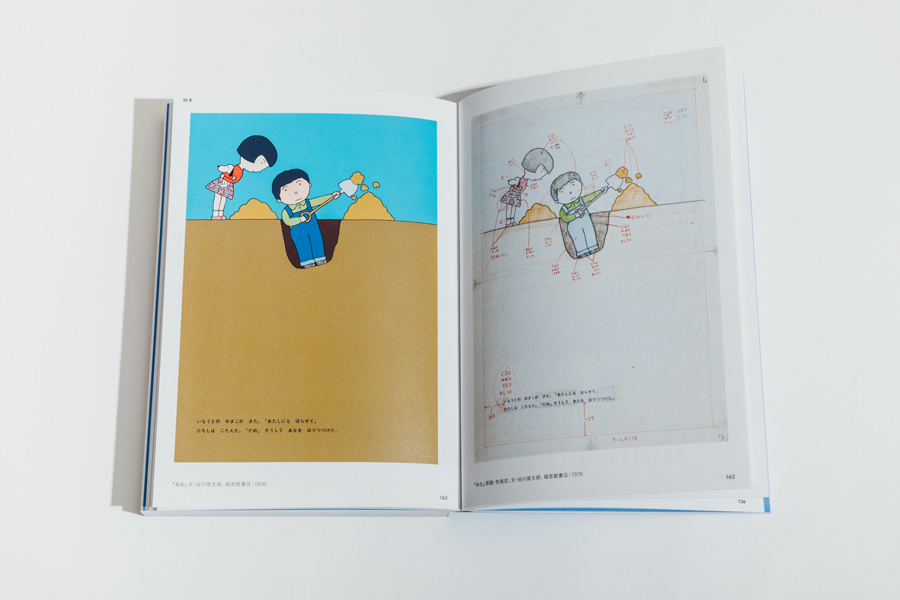
Catalogue, "Makoto Wada Exhibition", BlueSheep (2021). Photos by Nao Shimizu
Materials were donated to the Tama Art University Art Archives Center
ー I would like to move on from here to the archive. I heard that over 50,000 pieces of Mr. Wada's works and archival materials, including original drawings, prints, design works and primary documents, have been donated to the Tama Art University Art Archives Center. From 3 April to 13 May 2023, the first exhibition of Mr. Wada's archive materials, "The World of Makoto Wada I", was held at the Takeo Poster Collection Gallery at the university. It was very interesting to see the various materials on display that showed the process leading up to the finished product under the theme of "film". There were files with many indexes written in small letters, as well as boxes about the size of A4, perhaps grouped by project, with several envelopes inside which the materials were subdivided. There were also a lot of photographs of Charles Spencer Chaplin clipped from magazine articles, which I think were collected to illustrate Chaplin, and notebooks with detailed descriptions of the films he had seen and the names of the actors. Colour designations were written in red pen on tracing paper that had been applied to the prints, but as the designers were all busy, the words often looked as if they had been scribbled over, and if they were old, the tracing paper were often folded or torn, but they were very carefully written and in very good condition. They must have been stored properly.
Yoshida In Mr. Wada's office, the materials were very neatly organised. The office was a three-storey building, built in 1991 or so, and on the ground floor there were original drawings, finished posters, reference materials for his work, his own books and books he had contributed. The second floor was a meeting space, with more than 2,000 books bound by Mr. Wada on one wall.
The second floor is a meeting space with over 2,000 books designed by Mr. Wada on one wall. On the opposite side were his books and art books by Ben Shahn and others, as well as a collection of posters from foreign musical films and film reels (rolls of visual film). On the third floor was the production area, a kind of sanctuary for limited visitors, with desks for Mr. Wada and his staff, a photocopier, typographic materials, archive files of his work and CDs of Frank Sinatra and other artists he played while working. Mr. Wada's desk was a simple desk, not too big, like a study desk.
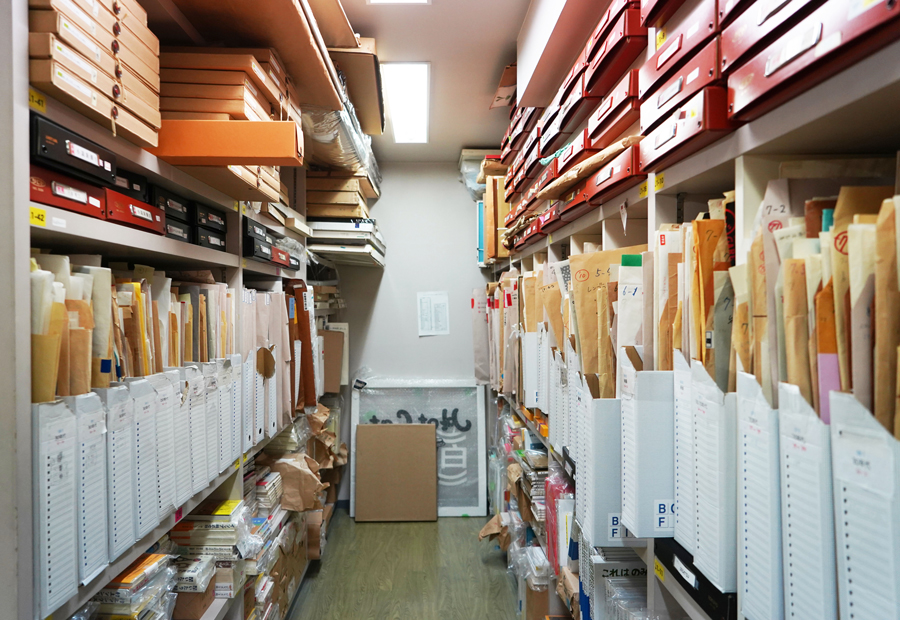
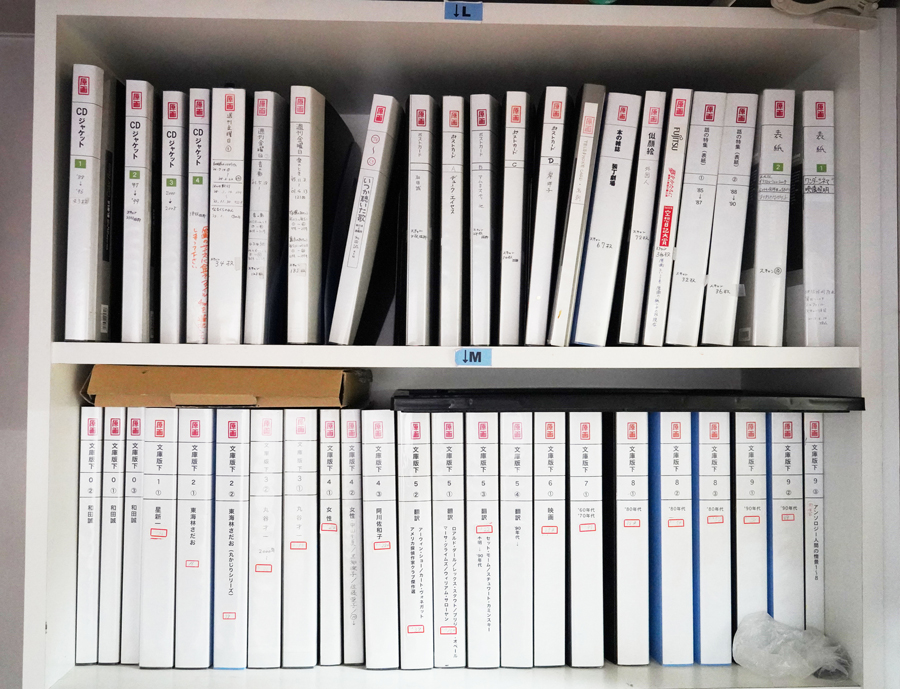
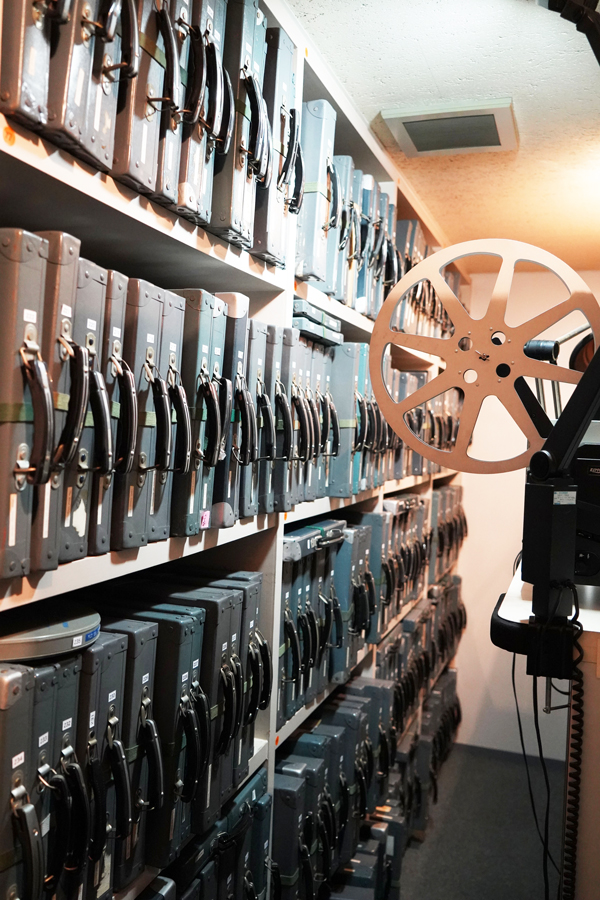
Materials stored in the Makoto Wada office. (From left to right) Original drawings, print files and films. Photos by Hiroko Yoshida
ー So all the documents were kept in the office. Were they organised by staff?
Yoshida The organising work was done by the staff, but I think it was Mr. Wada who was first instructed to organise the materials. There were more than 500 work files that had been clipped and compiled from newspaper and magazine serials, as well as other files such as newspaper articles that had been interviewed. There was a work management book, which contained a database of when and from whom the work was commissioned, what kind of work it was and when it was finished. It was very useful in organising the work and in the preparation process for the "Makoto Wada Exhibition".
ー In the "Makoto Wada Exhibition", there were drawings and picture diaries from Mr .Wada's childhood, picture stories, comic-style panel layouts, and even a book-like book with a back cover. Where were these stored?
Yoshida All were kept in the office. The picture story he drew when he was four years old seems to have been spelt out by his mother. The drawings were on the back of a programme print that his father, one of the founding members of Tsukiji Little Theater and a radio director at Japan Broadcasting Corporation Osaka Chuo Broadcasting Station when Mr. Wada was a child, used to bring home with him. Some of his works from his childhood have been neatly preserved and some were carefully kept by his friends. The notebooks in which he drew likenesses and cartoons of his teachers and classmates, as well as his film diaries, have been preserved. His work is connected to the things he has always loved since he was a child.
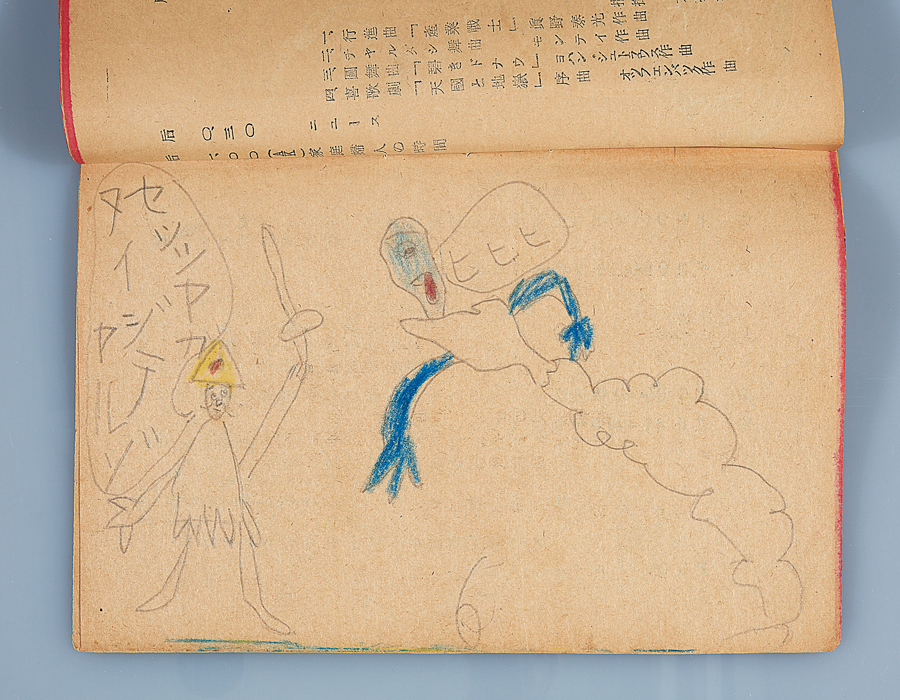
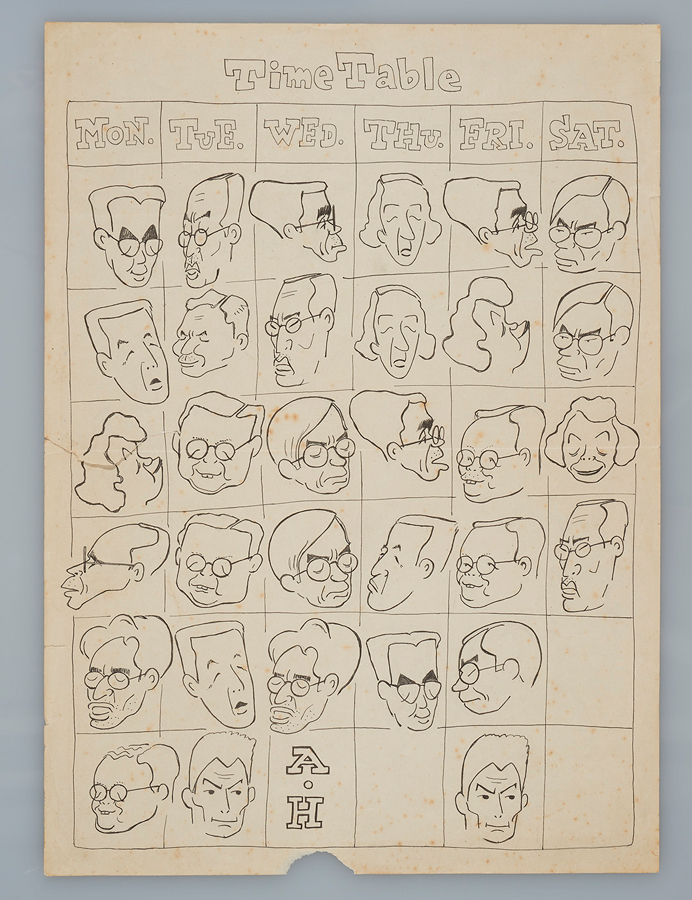
"Samuraitohebitoobake" (1940, left), which his mother bound a drawing he made when he was around four years old, and "Timetable by the likenesses of teachers" (1953), which he made when he was a sophomore in high school. Collection: Tama Art University Art Archives Center (Makoto Wada Archive)
ー The other day, I also visited the "Makoto Wada Memorial Library" on the fourth floor of the Shibuya Central Library in Shibuya City, Tokyo. There were bookshelves and meeting tables there that were actually used in the office, and I heard that these were custom-made by Mr. Wada. There was also a projector and other favourite items. There is also a considerable number of books in there: about 400 of his own books, about 2,000 bound books and about 1,200 documents, for a total of 3,700 books. Do you know how the donation came about?
Yoshida When the office was researching donation recipients, they asked if a memorial collection for Mr. Wada could be created, similar to the Ikenami Shotaro Memorial Museum in the public library. It was realised partly due to the fact that the office was located near this library. In addition to the books, posters, goods and some of his favourite items have also been donated, and the mini-exhibits in glass cases and on the walls change regularly - it's great to have a place where Mr. Wada's work and part of his collection can be seen all together, easily accessible to the public at any time. The chairs and desks were actually in his office, so those who had a direct association with Mr. Wada will be particularly moved by this.


In the "Makoto Wada Memorial Library" on the fourth floor of the Shibuya Central Library in Shibuya City, Tokyo, the tables and chairs used in the office are on display.
ー So, are Mr. Wada's archive materials available at the Tama Art University Art Archives Center and the Shibuya Central Library in Shibuya City, as well as at Makoto Wada's office and his home?
Yoshida The office has not been closed, but some of his books and posters are stored at his home.
ー Are posters and other materials also held by the DNP Foundation for Cultural Promotion?
Yoshida I think they probably are. There are also museums where Mr. Wada has exhibited in the past and where the current "Makoto Wada Exhibition" is touring. The collection of posters and reels of European and American films has been donated to the National Film Archive of Japan and part of the record collection has been donated to the Haruki Murakami Library. The National Film Archive of Japan will host the exhibition "Makoto Wada: The Work of Cinema (tentative title) " from 12 December 2023 to 24 March 2024. Also, after the donation process was complete, people who had been friends with Mr. Wada came to the office and took the remaining items home as mementos.
ー I get the impression from what you say that the donation of the archive materials went very smoothly, but who actually took the lead?
Yoshida It was mainly by the office staff in the office. It was a huge amount of material, so I think it was very hard work. The editors and others with whom he had a relationship helped him with his mementos. Although a farewell party was not held, it was nice to have close friends revisit the office and share their memories of Mr. Wada.
ー Archives have been discussed in Japan in recent years, but do you know whether Mr. Wada himself was aware of the need to preserve and archive materials when he was alive?
Yoshida Looking at his office, I think he was very conscious about organising and compiling his work.
In his later years, I once heard him say that "it would be good to have something like a memorial museum", and some people say they have heard him say, "It will be fine when I'm gone". I think he may have changed his mind from time to time.
When I see how many people visit the "Makoto Wada Exhibition" and how much they enjoy it, I feel that it would be nice to have a memorial museum, but I personally feel that it is very difficult to keep it going, so I need the cooperation of the government. It was really nice to have The Makoto Wada Memorial Library as a place where I could feel close to Mr. Wada.
ー Lastly, I would like to ask you about Ms. Yoshida's relationship with many other creators besides Mr. Wada through the magazine "Illustration". What do you think about the positioning of Mr. Wada's work in that era from your perspective as an editor?
Yoshida When Mr. Wada started his career, illustration was in its infancy, and it was a privileged time when it was easy to attract attention and take on a variety of work. I don't think there is anyone else who has been active in as many fields as Mr. Wada, but has left first-class work in all of them, and this has continued throughout his life. Most of us living in Japan have come into contact with Mr. Wada's work at some point in our lives. I think this is truly amazing. He was a pioneer in the early days of illustration and has continued to produce timeless works ever since.
The more I learn about Wada's work, the more I realise how great it is, but I wish I had heard more about him before he died, and I regret that I could have shaped the work we discussed on a chat level.
ー When a retrospective exhibition of a deceased person is organised, it is often done by relatives or staff, but I don't think there are many cases where an outsider such as Ms. Yoshida has made such an effort. On the contrary, it is probably a good thing that you are in an objective position. It is also rare to meet someone who is so deeply involved in the project, so it must have been a happy encounter for Ms. Yoshida.
Yoshida I am truly grateful.
ー Will the "Makoto Wada Exhibition" continue to tour?
Yoshida The "Makoto Wada Exhibition" will finish its tour at the Kariya City Art Museum in Aichi Prefecture, which will be held from 16 September to 5 November, I hear that the Tama Art University Art Archives Center will regularly hold special exhibitions of archive materials at the gallery on campus .
Mr. Wada's work is illustration and design, which is art in our daily lives, so I hope that there will be as many opportunities as possible for people to see and enjoy his work in the future. I hope I can continue to help in some small way.
ー Thank you very much for your valuable talk today.
Enquiry:
Tama Art University Art Archives Center
https://aac.tamabi.ac.jp
Makoto Wada's official website
https://wadamakoto.jp

